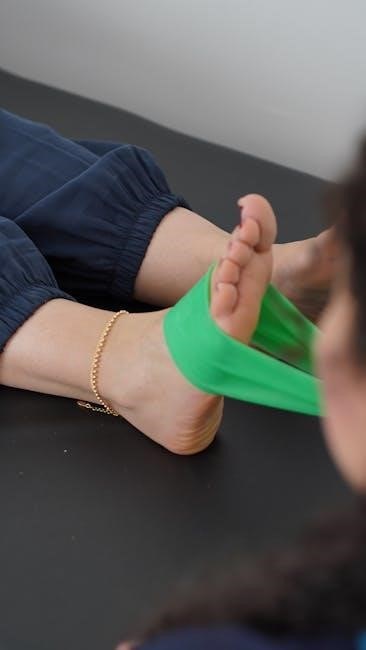Iliotibial Band Syndrome (ITBS) is a common condition causing pain and inflammation on the outside of the knee. It often results from repetitive friction or overuse, particularly in runners and cyclists. Key symptoms include sharp knee pain, swelling, and tenderness. Understanding ITBS is crucial for effective management through targeted exercises and lifestyle adjustments.
1.1. Definition and Overview of ITBS
Iliotibial Band Syndrome (ITBS) is a common condition characterized by inflammation and pain on the outside of the knee, caused by repetitive friction or overuse. The iliotibial band, a ligament that runs from the hip to the knee, becomes irritated when it rubs against the femur during activities like running or cycling. ITBS is often associated with sports but can also affect individuals with poor hip or knee mechanics. Symptoms include sharp pain, swelling, and tenderness near the knee joint. Early diagnosis and intervention are crucial to prevent chronic issues and restore mobility.
1.2. Importance of Exercises in Managing ITBS
Exercises play a vital role in managing ITBS by promoting flexibility, strength, and proper alignment. Stretching routines, such as the standing iliotibial band stretch and supine piriformis stretch, help reduce tension in the IT band. Strengthening exercises, including clamshell and glute bridges, improve hip stability and reduce strain on the knee. Consistency in these exercises can prevent chronic inflammation and enhance recovery. Additionally, dynamic stretching and foam rolling further aid in maintaining mobility and reducing muscle tightness. A structured exercise program not only alleviates symptoms but also supports long-term prevention of ITBS recurrence.

Understanding the Causes and Symptoms of ITBS
Iliotibial Band Syndrome (ITBS) is often caused by overuse, tight muscles, or poor training practices. Symptoms include sharp knee pain, swelling, and tenderness during activity.
2.1. Anatomical Factors Contributing to ITBS
Anatomical factors play a significant role in ITBS development. The iliotibial band (IT band), a ligament running down the thigh, can become inflamed when it rubs against the knee. Tightness in the tensor fasciae latae (TFL) and gluteal muscles increases friction on the IT band. Additionally, abnormal hip or knee alignment and weak core muscles can lead to poor movement patterns, exacerbating ITBS symptoms. Addressing these anatomical contributors through targeted exercises is essential for effective management and prevention.
2.2. Common Symptoms and Pain Patterns
Common symptoms of ITBS include sharp, stinging pain on the outside of the knee, especially during activities like running, cycling, or climbing stairs. Pain typically worsens with repetitive knee flexion and extension. Swelling and tenderness near the knee may also occur. Some individuals experience a snapping or popping sensation along the IT band. Pain often subsides with rest but returns with activity resumption. Cyclists and runners are particularly prone to these symptoms due to repetitive friction. Early recognition of these pain patterns is crucial for effective management and preventing further inflammation or damage.
The Role of Stretching in ITBS Management
Stretching plays a vital role in reducing IT band tension and improving flexibility. Regular stretching can alleviate pain and prevent further inflammation, enhancing overall mobility and recovery.
3.1. Standing Iliotibial Band Stretch
To perform the standing IT band stretch, cross one leg in front of the other and bend down, touching your toes. Keep your back straight and hold for 20-30 seconds. This stretch targets the IT band, reducing tension and improving flexibility. It’s essential to maintain proper form to avoid strain. Perform 2-3 sets on each leg, ideally after workouts or as part of your daily routine. Consistency is key for long-term relief and prevention of ITBS symptoms.
3.2. Side Leaning Iliotibial Band Stretch
Stand sideways near a wall with your injured leg farthest from it. Place the hand nearest the wall on the wall for balance. Slowly lean your hips toward the wall, keeping your legs straight, until you feel a stretch along the outside of your thigh. Hold for 20-30 seconds, then relax. Repeat 2-3 sets on each leg. This stretch effectively targets the IT band, helping to reduce tension and improve mobility. It’s a simple yet effective exercise for managing ITBS symptoms and preventing further discomfort.
3.3. Supine Piriformis Stretch for ITBS Relief
Lie on your back with knees bent and feet flat on the floor. Cross the affected leg over the unaffected thigh, placing the ankle on the opposite knee. Gently pull the unaffected leg toward your chest until a stretch is felt in the buttock of the affected side. Hold for 10-15 seconds, then relax. Repeat 2-3 sets. This stretch targets the piriformis muscle, which, when tight, can contribute to IT band tension. Regular practice helps alleviate pain and improves hip mobility, making it an essential exercise for ITBS management.

Strengthening Exercises for ITBS
Strengthening exercises are crucial for ITBS management, focusing on hip stability and muscle balance. They reduce pain and improve functional movement, essential for long-term recovery and prevention.
4.1. Clamshell Exercise for Hip Stability
The Clamshell exercise targets the gluteus medius and minimus, improving hip stability. Lie on your side with knees bent and feet touching. Slowly lift the top knee while keeping the feet together, maintaining control. Perform 3 sets of 15-20 repetitions. This exercise strengthens the hips, reducing IT band strain and improving running or cycling efficiency. Consistency is key for long-term benefits and injury prevention.
4.2. Side-Lying Abduction for Glute Strength
Side-Lying Abduction targets the gluteus medius and minimus, essential for hip stability. Lie on your side with legs straight and feet touching. Lift the top leg while keeping the foot flexed and knee straight. Avoid rotating the hip. Perform 3 sets of 15-20 repetitions. This exercise strengthens the glutes, reducing IT band strain and improving lower limb alignment. Proper form is crucial to avoid compensatory movements. Consistency in this exercise helps enhance hip function and reduces the risk of ITBS recurrence, making it a cornerstone of rehabilitation and prevention programs.
4.3. Glute Bridges to Improve Hip Function
Glute bridges are an effective exercise for strengthening the glutes and improving hip function. Lie on your back with knees bent and feet flat on the floor. Engage your core, lift your hips toward the ceiling, squeezing your glutes at the top. Slowly lower your hips back down to the starting position. This exercise targets the gluteus maximus and hamstrings, enhancing hip stability and extensor strength. Regular practice improves pelvic alignment and reduces IT band tension. Aim for 3 sets of 12-15 repetitions, focusing on controlled movements to maximize benefits and prevent strain. This exercise is crucial for addressing hip dysfunction related to ITBS.

Foam Rolling and Self-Myofascial Release
Foam rolling and self-myofascial release are essential for reducing IT band tension and improving circulation. Regular use can alleviate pain and enhance recovery by breaking down scar tissue and adhesions.
5.1. Techniques for Foam Rolling the IT Band
Foam rolling the IT band involves using a large foam roller to apply pressure along the outer thigh. Start by lying on your side with the affected leg on top. Place the foam roller just above the knee and slowly roll upward toward the hip. Use your opposite leg and hand to control the pressure and movement. Focus on areas of tension, holding for 20-30 seconds to release tightness. Roll slowly and avoid bouncing, as this can cause discomfort. Repeat for 2-3 passes, gradually increasing pressure as needed. This technique helps reduce inflammation and improve circulation, promoting healing and flexibility.
5.2. Importance of Consistency in Foam Rolling
Consistency is crucial for effective foam rolling in managing ITBS. Regular sessions ensure sustained tissue recovery and long-term benefits. Irregular use may not yield lasting relief, as inflammation and tightness can recur. Aim for daily or every-other-day sessions, focusing on gentle, controlled movements. Over time, consistent foam rolling enhances circulation, reduces muscle tightness, and promotes healing. It also helps maintain flexibility and strength in the IT band and surrounding muscles. Without regular practice, progress may plateau, and symptoms could persist or worsen. Incorporating foam rolling into your routine is essential for achieving and maintaining optimal recovery from ITBS.

Dynamic Stretching and Mobility Exercises
Dynamic stretching enhances mobility and reduces stiffness in the IT band. Exercises like leg swings and lunges improve flexibility and prepare muscles for activity, preventing tightness.
6.1. Leg Swings for Hip Mobility
Leg swings are a dynamic exercise that enhances hip mobility and loosens the IT band. Stand with one hand against a wall for balance. Swing the unaffected leg forward and backward, then side to side, gradually increasing the range of motion. Perform 2-3 sets of 10-15 swings per leg. This exercise improves flexibility and reduces tension in the IT band, making it an essential part of ITBS management and prevention.
6.2. Lunges for Functional Movement Patterns
Lunges are a functional exercise that mimics daily movement patterns, helping to strengthen the muscles around the IT band. Stand with feet hip-width apart, step forward with one leg, and lower your body until both knees are bent at 90 degrees. Ensure the back knee nearly touches the ground and the front knee doesn’t extend past the toes. Push back to the starting position and repeat with the other leg. This exercise improves balance, coordination, and hip stability while reducing IT band tension, making it beneficial for both ITBS management and prevention.

Home Exercise Program for ITBS
A structured routine combining stretching, strengthening, and endurance exercises, as outlined by the AAHKS, helps manage ITBS symptoms effectively, with noticeable improvement typically after 6 weeks.
7.1. Sample Routine from the American Association of Hip and Knee Surgeons
The American Association of Hip and Knee Surgeons recommends a comprehensive home exercise program for ITBS. The routine includes stretching exercises such as the supine piriformis stretch, where the patient lies on their back, pulls the affected knee toward the opposite shoulder, and holds for 10 seconds, repeating 2-3 times daily. Strengthening exercises like side-lying abductions are also emphasized to target the gluteus medius. Patients are advised to perform these exercises 2-3 times a day, gradually increasing repetitions and frequency over time to improve IT band flexibility and reduce pain.
7.2. Progression of Exercises Over Time
Exercises for ITBS should progress gradually to avoid overloading the tissues. Initially, focus on gentle stretches and low-resistance strengthening. As pain subsides, introduce more dynamic movements and resistance, such as elastic bands. Over time, incorporate functional exercises like lunges and single-leg balances to improve stability. Patients are encouraged to increase repetitions and intensity as tolerance allows. Consistency is key, with improvements typically noticed after 6-8 weeks of regular practice. Progression should be tailored to individual recovery, ensuring exercises remain challenging yet manageable to promote long-term relief and prevent recurrence.

Preventative Exercises for IT Band Health
Preventative exercises focus on strengthening the gluteus medius and improving core stability to reduce IT band strain. Regular stretching and proper footwear can also prevent recurrence. Consistency is key.
8.1. Strengthening the Gluteus Medius
Strengthening the gluteus medius is essential for preventing ITBS, as weak glutes can lead to poor hip and knee alignment during movement; Exercises like clamshell and side-lying abductions target this muscle, improving hip stability and reducing strain on the IT band. Start with low resistance and progress gradually. Incorporate these exercises 2-3 times weekly for optimal results. Strong glutes help maintain proper movement patterns, reducing the risk of ITBS recurrence. Consistency is key to long-term benefits and overall lower limb health.
8.2. Core Stability Exercises to Reduce IT Band Strain
Core stability exercises are vital for reducing IT band strain by improving lower back and hip stability. Planks, bird-dog exercises, and pelvic tilts strengthen the abdominal and spinal muscles, enhancing posture and movement patterns. These exercises help maintain proper hip alignment, reducing unnecessary strain on the IT band during physical activities. Incorporate core work 2-3 times weekly, focusing on controlled movements and proper form. Strong core muscles provide a stable foundation, minimizing the risk of ITBS flare-ups and promoting long-term hip and knee health.

Single-Leg Balance and Proprioception Training
Single-leg balance exercises improve proprioception and stability, reducing ITBS risk. Perform barefoot or in socks, near a wall for support, on a non-slip surface. Enhances balance and injury prevention.
9.1. Single-Leg Balance Knee Bent Exercise
Stand on one leg, bending the knee slightly, and hold for 20-30 seconds. Perform near a wall for safety. This improves balance, stability, and hip function, reducing ITBS risk and enhancing overall lower limb coordination. Regular practice strengthens the muscles around the knee and hip, promoting proper alignment and reducing strain on the iliotibial band. Start with shorter durations and gradually increase as balance improves. This exercise is essential for athletes and individuals with ITBS to restore proprioception and prevent further injury.
9.2. Improving Balance for Injury Prevention
Enhancing balance is crucial for preventing ITBS-related injuries, as it strengthens the stabilizing muscles around the hips and knees. Single-leg exercises, such as standing on one leg with a slight knee bend, improve proprioception and reduce the risk of overuse injuries. Perform these exercises barefoot or in socks on a non-slip surface, holding for 20-30 seconds per leg. Incorporate balance drills into your routine 2-3 times weekly to enhance overall stability and lower limb coordination, which are vital for long-term injury prevention and maintaining proper biomechanics during physical activities.

The Role of Elastic Bands in Rehabilitation
Elastic bands provide resistance for strengthening hip muscles, aiding in ITBS recovery. They are versatile, portable tools for exercises targeting gluteus medius and hip stabilizers effectively.
10.1. Elastic Band Exercises for Hip Rehabilitation
Elastic bands are effective for strengthening hip muscles, crucial for ITBS recovery. Loop the band around your ankles and perform side steps, keeping tension. This targets the gluteus medius. Stand with the band secured below knee height and abduct your leg against resistance. Aim for 3 sets of 10-15 reps. These exercises improve hip stability and reduce IT band strain. Portable and affordable, elastic bands are ideal for daily routines. The American Association of Hip and Knee Surgeons recommends such exercises for comprehensive hip rehabilitation, enhancing strength and flexibility.
10.2. Incorporating Resistance Bands into Daily Routines
Resistance bands are versatile tools for daily ITBS rehabilitation. Begin with side-lying leg lifts, looping the band around your ankles. Perform 3 sets of 10-15 reps. Use the band for clamshell exercises by wrapping it around your knees. Focus on slow, controlled movements to engage the glutes. For added challenge, incorporate banded lunges and leg abductions. These exercises strengthen hip muscles and improve joint stability. The portability of resistance bands makes them ideal for consistent practice, even while traveling. Aim to include banded exercises in your daily routine to enhance hip function and reduce IT band tension effectively.

Recovery and Rest Strategies
Rest is crucial for ITBS recovery, allowing tissues to heal. Ice therapy reduces inflammation and alleviates pain. Consistency in rest and rehabilitation ensures proper healing and prevents recurrence.
11.1. The Importance of Rest in ITBS Recovery
Rest plays a vital role in ITBS recovery by allowing the inflamed iliotibial band to heal. Avoid activities that aggravate the condition, such as running or cycling, during the recovery phase. The American Association of Hip and Knee Surgeons recommends incorporating rest alongside stretching and strengthening exercises for optimal results. Adequate rest prevents further irritation and promotes tissue repair. It is essential to balance rest with gentle, low-impact movements to maintain mobility. Consistency in rest and rehabilitation ensures proper healing and reduces the risk of recurrence. Recovery typically requires several weeks, with noticeable improvement often seen after 6-8 weeks of consistent effort.
11;2. Ice Therapy for Reducing Inflammation
Ice therapy is a cornerstone in managing ITBS inflammation. Applying an ice pack wrapped in a cloth to the affected area reduces swelling and pain. The American Association of Hip and Knee Surgeons suggests icing for 15-20 minutes, 2-3 times daily, especially after activity. This practice helps numb the area, minimizing discomfort and muscle spasms. Consistency is key, as regular icing can significantly reduce inflammation. It is most effective in the acute phase of recovery. Combine icing with rest and gentle exercises for optimal healing. This approach supports the body’s natural repair process, aiding in faster recovery and return to activity.
When to Seek Professional Help
Seek professional help if ITBS symptoms persist despite consistent exercises, rest, and ice therapy. Consult a specialist if experiencing severe pain, swelling, or limited mobility.
12.1. Signs That Indicate the Need for Medical Intervention
If symptoms like sharp knee pain, swelling, or limited mobility persist despite rest and exercises, medical help is necessary. Severe pain during activities or at rest, inability to bend the knee, or noticeable swelling should prompt a specialist consultation. The American Association of Hip and Knee Surgeons (AAHKS) recommends seeking professional advice if symptoms worsen or fail to improve with home exercises. Early intervention can prevent further complications and ensure proper recovery.
12.2. Role of Physical Therapy in ITBS Management
Physical therapy plays a vital role in managing ITBS by addressing muscle imbalances and improving joint mobility. Therapists design personalized exercise programs focusing on strengthening the glutes and hips, as well as stretching the IT band. Techniques like foam rolling and dynamic stretching are often incorporated to reduce tightness and enhance flexibility. The American Association of Hip and Knee Surgeons (AAHKS) emphasizes the importance of structured rehabilitation plans tailored to individual needs. Regular physical therapy sessions can accelerate recovery, prevent recurrence, and restore optimal function for daily activities and sports performance.
Accessing ITBS Exercise Guides and PDF Resources
Reliable sources like the American Association of Hip and Knee Surgeons (AAHKS) offer detailed ITBS exercise guides in PDF format. These resources include stretching routines, strengthening exercises, and foam rolling techniques to alleviate symptoms and improve mobility. Websites such as sportsrehab.ucsf;edu and dartmouth-hitchcock.org provide accessible materials for personalized treatment plans.
13.1. Reliable Sources for ITBS Exercise PDFs
Several reputable organizations provide ITBS exercise guides in PDF format. The American Association of Hip and Knee Surgeons (AAHKS) offers comprehensive home exercise programs focusing on stretching, strengthening, and endurance. Additionally, UCSF Sports Rehabilitation and Dartmouth-Hitchcock Health publish detailed ITBS exercise protocols, including stretching routines, foam rolling techniques, and strengthening exercises. These resources are designed to help individuals create personalized treatment plans tailored to their specific needs, offering clear instructions and progression guidelines for optimal recovery and prevention of ITBS.
13.2. How to Create a Personalized Exercise Program
Creating a personalized exercise program for ITBS involves assessing individual needs, goals, and current fitness levels. Start by selecting exercises from reliable sources, such as those provided by the American Association of Hip and Knee Surgeons (AAHKS) or sports rehabilitation clinics. Focus on combining stretching, strengthening, and mobility exercises tailored to your specific symptoms. Adjust the frequency and intensity based on your progress and pain levels. Incorporate activities that promote functional movement and hip stability. Track your progress and modify the program as needed to ensure long-term relief and prevention of ITBS recurrence.
14.1. Summary of Key Points for Effective ITBS Management
Effective ITBS management involves a combination of stretching, strengthening, and foam rolling exercises. Stretching improves flexibility, while strengthening targets the glutes and core to reduce strain on the IT band. Foam rolling and self-myofascial release help alleviate tightness. Incorporating dynamic stretches and mobility exercises, such as leg swings and lunges, enhances functional movement. Consistency in these exercises, along with proper rest and recovery, is crucial. A personalized exercise program, guided by resources from the American Association of Hip and Knee Surgeons, ensures tailored relief. Over time, this holistic approach reduces pain, improves function, and prevents recurrence, allowing individuals to maintain an active lifestyle with confidence.
14.2. Encouragement for Long-Term Consistency
Consistency is key to managing ITBS effectively. While progress may seem slow, sticking to a structured exercise plan ensures gradual improvement. The American Association of Hip and Knee Surgeons emphasizes that it may take 6 weeks or more to notice significant relief. Persistence in performing stretches, strengthening exercises, and foam rolling is vital. Celebrate small victories, like increased flexibility or reduced pain, to stay motivated. Over time, these efforts will lead to lasting relief and improved function, allowing you to maintain an active lifestyle with confidence and reduced risk of recurrence. Stay committed, and your body will thank you.

